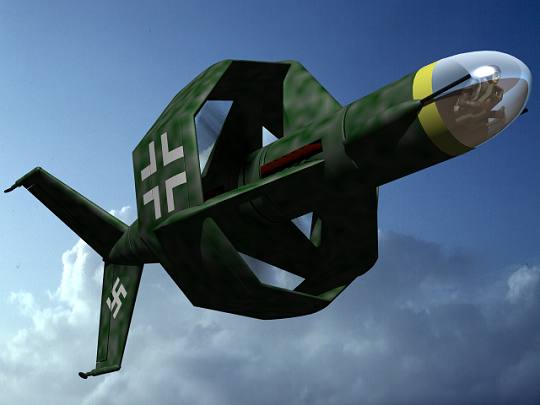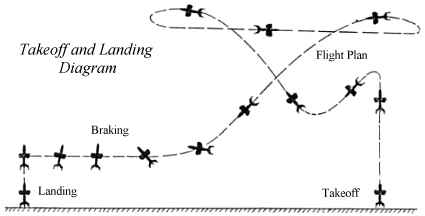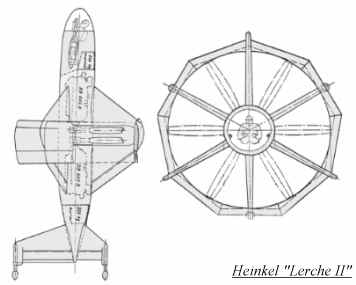Heinkel "Lerche II"

Pictures by Dan Johnson, more info on Luft '46 at http://www.luft46.com.
There is also a ready to play counter version.
This Heinkel VTOL (Vertical TakeOff and Landing) fighter/interceptor was based on an earlier design, the "Wespe" (Wasp). Engineer Reiniger of the Heinkel company in Vienna started the design work on February 25, 1935 and completed the design on March 8, 1937. The "Lerche" (Skylark) employed a ducted wing planform with contrarotating propellors, powered by two Daimler Benz DB605D engines. The pilot lay in a prone position in the extreme nose, and projected armament was two MK 108 30mm cannon.
The extreme profile of this craft requires a quite unusual tactic; the pilot must swoop in an attack run, plot an intercept course, and then disappear, only to turn back for another run. As no other aircraft is capable of catching the Lerche on such a run, an accomplished pilot can attack a heavy target, such as a bomber or zeppelin, at will.

The VTOL capacity means the Lerche doesn't have to operate off airfields; a concrete slab in a clearing in the forest works just as well. The plane can actually land in preparation for an ambush, and thus use it's VTOL capacity as a tactical asset at low altitudes. It can also be launched straight out of a zeppelin hanger, with no need for a skyhook or landing deck. This makes up for the short range; the craft can be deployed right next to the expected action. It can also set down rather than patrol, awaiting prey standing on the ground.

The pilot hangs suspended inside a large bubble canopy; vision is excellent, and the unusual headfirst position gives a feeling of power and freedom never experienced in a regular pilot's seat. One pilot felt as if he was a flying man; the machine was all but forgotten.
The drawback is that the Lerche is extremely dependent on it's engines running constantly at near full power. Low speed maneuvering is hazardous, and fuel consumption is prodigious. The experimental fuselage is very strong, but the engines' power puts enormous stress on the structure and battle damage can quickly reduce the Lerche to a cloud of debris.
| Name | Heinkel "Lerche II" |
| Base Target Number | 8 |
| Speed | 5 |
| G-rating | 1 |
| Acceleration | 2 |
| Gun 1 | 60 |
| Gun 2 | 60 |
| 4 Hardpoints | |
| Armor | 110 |
|
50 |
|
60 |
| Free Weight | 0 |
Special Rules: The Lerche uses the Autogyro damage template from Wings over Manhattan. It can also do the two-turn stall, but must calculate G forces normally and doesn't get the extra hexside of turning ability. Any damage resulting from pushing G:s affect the rear fuselage.
Heinkel "Lerche II" |
Class:
Light Fighter (Mid-engine) |
||||
|
Manufacturer:
Heinkel Vienna, Austria |
Engine:
Twin Daimler Benz DB605D engines |
||||
| Wing Span: 4 m (13' 1.6") |
Length: 9.4 m (30' 10.4") |
Height: 4 m (13' 1.6") |
Loaded Weight: 2000 kg (4500 lbs) |
Service Ceiling: 5,500 m (18,000') |
Range: 120 km (75 miles) |
| Max. Speed: 560 kph (350 mph) |
Max Accel: 10 m/s2 (32.8 feet/second) |
Max Decel: 20 m/s2 (65.6 feet/second) |
|||
Design
| Base Complexity | 13 | ||
| VTOL craft | +3 | ||
| Ground Clumsy | -1 | ||
| Improved Cockpit Visibility | +1 | ||
| Light Stick | +1 | ||
| Expensive | -1 | ||
|
|
|||
| Total | 16 | ||
| Cost | $11.000 | ||
Note: While Luft '46 is a historical site, this description is entirely fictional. Facts from Luft '46 have been altered and new ideas added to fit this design into the Crimson Skies pulp universe. For historical information, check out the source at Luft '46.